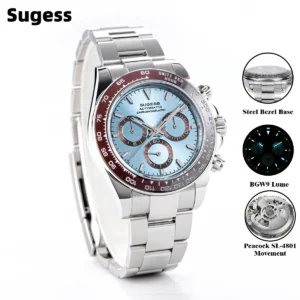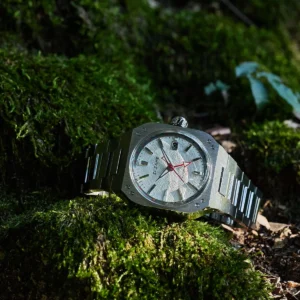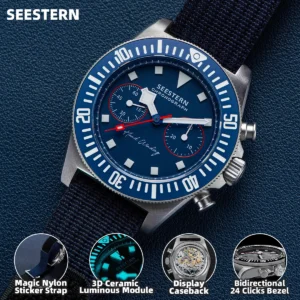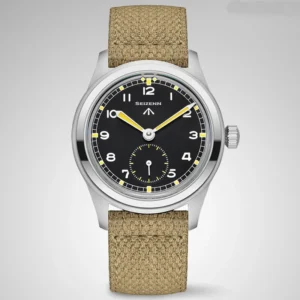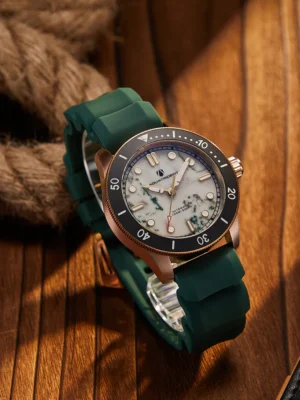Automatic Chronograph Watches
Discover watches with a stopwatch inside. Automatic chronographs self-wind with your motion, offering precision timing for any event and a view into mechanical craft.

Showing all 6 results
Automatic Chronograph Watches, Chronograph Pilot Watches
Price range: $233.36 through $237.58 Select options This product has multiple variants. The options may be chosen on the product pageAutomatic Chronograph Watches, Classic Automatic Dress Watches, Classic Style Dive Watches
$617.17 Select options This product has multiple variants. The options may be chosen on the product pageAutomatic Chronograph Watches, Classic Style Dive Watches
$3,053.06 Select options This product has multiple variants. The options may be chosen on the product pageAutomatic Chronograph Watches, Automatic Skeleton Watches, Classic Automatic Dress Watches
$3,054.42 Select options This product has multiple variants. The options may be chosen on the product pageAutomatic Chronograph Watches, Classic Automatic Dress Watches, Day Date Automatic Watches
$720.32 Select options This product has multiple variants. The options may be chosen on the product pageAutomatic Chronograph Watches, Automatic Skeleton Watches, Chronograph Pilot Watches
$1,693.20 Select options This product has multiple variants. The options may be chosen on the product page
Showing all 6 results
Understanding Automatic Chronograph Watches
At the intersection of traditional watchmaking and functional precision lies the automatic chronograph watch—a remarkable feat of mechanical engineering. These sophisticated timepieces combine two distinct mechanisms: a self-winding automatic movement that harnesses energy from your natural wrist motion, and a chronograph function that offers precise stopwatch capabilities.
The beauty of automatic chronographs lies in their mechanical complexity. Unlike their quartz counterparts, these watches operate without batteries, instead relying on an intricate system of gears, levers, and springs to track both time and measured intervals. Each piece represents thousands of hours of development and centuries of horological tradition.
At Sharp Aspect, we celebrate these timepieces as the perfect marriage of tradition and function—watches that showcase mechanical ingenuity while delivering practical utility. The chronograph functionality not only provides useful timing capabilities but also adds visual depth and character to the watch dial, creating a compelling aesthetic that watch enthusiasts cherish.
The Heritage of Automatic Chronographs
The story of automatic chronographs represents one of watchmaking’s most exciting chapters. The year 1969 marked a watershed moment in horological history when three separate entities—Heuer (partnered with Breitling, Büren, and Dubois-Dépraz), Zenith, and Seiko—raced to develop the world’s first self-winding chronograph movement.
This competition to integrate automatic winding with chronograph functionality resulted in groundbreaking innovations that forever changed the landscape of fine watchmaking. What makes these timepieces special is how they connect modern wearers to this rich heritage of innovation and craftsmanship.
Today’s automatic chronographs carry forward this legacy of excellence, with modern manufacturing techniques enhancing the reliability and precision of these complex mechanisms without sacrificing their traditional appeal. For discerning collectors, owning an automatic chronograph means possessing a piece of living horological history.
How Automatic Chronograph Movements Work
The genius of automatic chronographs lies in their seamless integration of two sophisticated systems. At their core, these watches feature a self-winding mechanism centered around a semi-circular weight called a rotor. As you move your wrist throughout the day, this rotor spins, transferring energy through a series of gears to wind the mainspring—essentially storing potential energy.
This energy powers the timekeeping function of the watch, which operates continuously. The chronograph function, however, remains dormant until activated. When you press the top pusher (typically positioned at 2 o’clock), the chronograph mechanism engages through either a column wheel or cam system—the former being more traditional and usually found in higher-end pieces.
The engagement process connects the chronograph wheels to the running movement through a clutch mechanism. This allows the chronograph seconds hand to sweep smoothly across the dial while recording elapsed time without affecting the accuracy of the main timekeeping function.
Power reserve—the duration a fully wound watch will run without additional motion—deserves special consideration in automatic chronographs. The additional complexity of the chronograph mechanism often results in increased energy consumption, typically yielding power reserves between 40-70 hours depending on the movement’s design.
The Anatomy of an Automatic Chronograph Watch
Automatic chronographs feature distinctive external components that telegraph their sophisticated functionality. Their cases are often slightly thicker than time-only watches to accommodate the complex movement within. Most designs feature two pushers flanking the crown—the top pusher starts and stops the chronograph, while the bottom resets it.
The dial layout reveals the chronograph’s purpose, typically featuring:
- A central seconds hand for chronograph timing (different from a small seconds hand)
- Sub-dials (typically 2-3) displaying:
- Running seconds
- Minute counter (usually tracking 30 minutes)
- Hour counter (on three-register chronographs)
Many sport chronographs feature tachymeter scales on their bezels or chapter rings, allowing the wearer to calculate speed or distance when used with the chronograph function. Like our open heart automatic watches, many automatic chronographs feature exhibition casebacks that showcase the complex movement within, revealing the fascinating interplay of wheels, levers, and springs.
The Aesthetic Appeal of Automatic Chronographs
The visual draw of automatic chronographs stems from their purposeful complexity. The symmetrical arrangement of sub-dials creates a balanced, technical appearance that appeals to enthusiasts who appreciate mechanical sophistication. The pushers add distinctive character to the case profile, creating an immediately recognizable silhouette.
Like mechanical skeleton watches, automatic chronographs celebrate the relationship between form and function. Each element serves a purpose while contributing to the overall aesthetic appeal. The dial complexity—with its multiple scales, hands, and registers—creates visual interest and reflects the watchmaker’s craft.
The design versatility within this category is remarkable, ranging from racing-inspired pieces with high-contrast dials and bold colors to dressy chronographs with restrained palettes and refined finishes. This variety ensures there’s an automatic chronograph to match any personal style or preference.
Key Features to Consider When Selecting an Automatic Chronograph
When exploring Sharp Aspect’s collection of automatic chronographs, consider these important features:
Movement Architecture: Integrated chronograph movements are built as a unified system, while modular designs add chronograph functionality atop a base movement. Integrated movements are generally more coveted for their seamless design.
Case Materials: From classic stainless steel to lightweight titanium or luxurious gold, the case material affects both aesthetics and wearability.
Water Resistance: While not typically dive watches, quality automatic chronographs should offer at least 50-100m water resistance. Our most robust models approach the capabilities found in our professional spec dive watches.
Crystal Type: Sapphire crystal offers superior scratch resistance compared to mineral crystal, protecting your investment for years to come.
Chronograph Layout: Two-register (bi-compax) or three-register (tri-compax) configurations offer different functionality and aesthetic appeal.
Movement Finishing: Higher-end pieces feature decorative techniques like Geneva stripes, perlage, or blued screws visible through exhibition casebacks.
Our Curated Collection of Automatic Chronographs
At Sharp Aspect, we carefully evaluate each automatic chronograph against stringent criteria before adding it to our collection. We assess movement quality, case construction, dial execution, and overall finishing to ensure every piece delivers exceptional value. Our selection spans from accessible entry points into the world of automatic chronographs to more exclusive limited editions.
Each timepiece we offer represents our commitment to horological excellence, balancing traditional craftsmanship with modern reliability. We seek watches with character—timepieces that tell stories through their design and execution while maintaining the precision and functionality that defines this category.
Classic Chronograph Designs
Our classic chronograph collection features timepieces with balanced proportions and refined aesthetics that transcend passing trends. These watches often draw inspiration from iconic mid-century designs, with clean dials, thoughtfully sized cases (typically 38-42mm), and versatile styling that transitions effortlessly from business attire to casual wear.
Like our classic automatic dress watches, these pieces emphasize readability and elegance while maintaining their functional capabilities. The restrained use of color, applied hour markers, and thoughtfully proportioned hands create watches that will look as appropriate decades from now as they do today.
Sport and Racing Chronographs
Our sport-oriented chronographs embrace bold aesthetics and enhanced functionality. These watches typically feature high-contrast dials for improved readability, with accent colors highlighting key timing elements. Tachymeter scales—allowing speed calculations over measured distances—connect these timepieces to their motorsport heritage.
Many of our sport chronographs share DNA with chronograph pilot watches, offering enhanced legibility and robust construction. Larger pushers for easier operation with gloves, reinforced cases, and specialized scales make these watches true tools for timing and calculation, not merely decorative accessories.
Investment Value and Longevity
Automatic chronographs represent thoughtful investments rather than mere purchases. The mechanical nature of these timepieces means that, with proper care, they can function reliably for decades or longer. Unlike electronic devices designed for obsolescence, quality chronograph watches often become heirlooms, passing between generations.
The craftsmanship invested in these pieces—from movement assembly to case finishing—creates lasting value that often appreciates over time, particularly for limited editions or models from storied manufacturers. This stands in stark contrast to the disposable nature of many modern consumer goods.
By choosing an automatic chronograph, you’re participating in a tradition of sustainable luxury—investing in an object designed to be repaired rather than replaced, maintaining its function and beauty for decades.
Caring for Your Automatic Chronograph
To ensure your automatic chronograph provides decades of reliable service:
Wear regularly: The self-winding mechanism works best with consistent wear. If unworn for extended periods, gently wind the crown 20-30 turns before wearing.
Store properly: When not worn, keep your watch in a watch box or winder to maintain power and keep lubricants distributed.
Service periodically: Have your chronograph professionally serviced every 5-7 years to ensure optimal performance and longevity.
Use the chronograph function judiciously: While designed for regular use, avoid leaving the chronograph running continuously as this increases wear on the mechanism.
Maintain water resistance: Have gaskets checked regularly, especially before water exposure, and ensure pushers and crown are fully secured before contact with water.
Why Enthusiasts Choose Automatic Chronographs
Watch enthusiasts gravitate to automatic chronographs for their compelling blend of artistry and utility. The tactile experience of operating a mechanical chronograph—feeling the precise click of the pushers engaging the mechanism—creates a connection between wearer and timepiece that electronic watches simply cannot match.
These watches represent mechanical poetry on the wrist—the visible sweep of the chronograph seconds hand, the balanced arrangement of sub-dials, and the knowledge that hundreds of components are working in perfect harmony beneath the dial. For many, an automatic chronograph expresses not just personal style but an appreciation for craftsmanship and mechanical ingenuity that transcends mere timekeeping.




